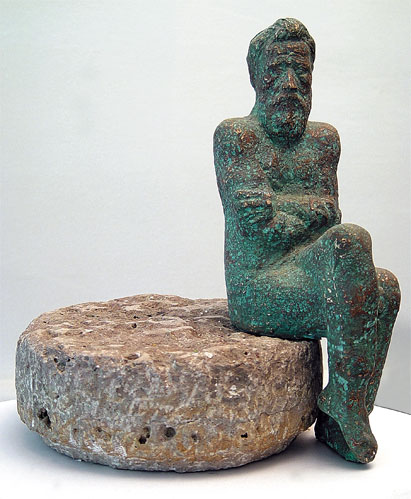Brâncuși grew up in the village of Hobiţa Romania, Gorj, near Târgu Jiu, close to Romania's Carpathian Mountains, an area known for its rich tradition of folk crafts, particularly woodcarving. Geometric patterns of the region are seen in his later works.
His parents Nicolae and Maria Brâncuși were poor peasants who earned a meager living through back-breaking labor; from the age of seven, Constantin herded the family's flock of sheep. He showed talent for carving objects out of wood, and often ran away from home to escape the bullying of his father and older brothers.
At the age of nine, Brâncuși left the village to work in the nearest large town. At 11 he went into the service of a grocer in Slatina; and then he became a domestic in a public house in Craiova where he remained for several years. When he was 18, Brâncuși created a violin by hand with materials he found around his workplace. Impressed by Brâncuși's talent for carving, an industrialist entered him in the Craiova School of Arts and Crafts (școala de arte și meserii), where he pursued his love for woodworking, graduating with honors in 1898.
He then enrolled in the Bucharest School of Fine Arts, where he received academic training in sculpture. He worked hard, and quickly distinguished himself as talented. One of his earliest surviving works, under the guidance of his anatomy teacher, Dimitrie Gerota, is a masterfully rendered écorché (statue of a man with skin removed to reveal the muscles underneath) which was exhibited at the Romanian Athenaeum in 1903.Though just an anatomical study, it foreshadowed the sculptor's later efforts to reveal essence rather than merely copy outward appearance.
In 1903, Brâncuși traveled to Munich, and from there to Paris. In Paris, he was welcomed by the community of artists and intellectuals brimming with new ideas.[3] He worked for two years in the workshop of Antonin Mercié of the École des Beaux-Arts, and was invited to enter the workshop of Auguste Rodin. Even though he admired the eminent Rodin he left the Rodin studio after only two months, saying, "Nothing can grow under big trees."
His works became popular in France, Romania and the United States. Collectors, notably John Quinn, bought his pieces, and reviewers praised his works. In 1913 Brâncuși's work was displayed at both the Salon des Indépendants and the first exhibition in the U.S. of modern art, the Armory Show.
In 1920, he developed a notorious reputation with the entry of "Princess X" [1] in the Salon. The phallic shape of the piece scandalized the Salon, and despite Brâncuși's explanation that it was an anonymous portrait, removed it from the exhibition. "Princess X" was revealed to be Princess Marie Bonaparte, direct descendant of the younger brother of Napoleon Bonaparte.
In 1938, he finished the World War I monument in Târgu-Jiu where he had spent much of his childhood. "Table of Silence", "The Gate of the Kiss", and "Endless Column" commemorate the courage and sacrifice of Romanian civilians who in 1916 fought off a German invasion. The restoration of this ensemble was spearheaded by the World Monuments Fund and was completed in 2004.
The Târgu Jiu ensemble marks the apex of his artistic career. In his remaining 19 years he created less than 15 pieces, mostly reworking earlier themes, and while his fame grew he withdrew. In 1956 Life magazine reported, "Wearing white pajamas and a yellow gnomelike cap, Brâncuși today hobbles about his studio tenderly caring for and communing with the silent host of fish birds, heads, and endless columns which he created."
He died on March 16, 1957 at the age of 81 leaving 1200 photographs and 215 sculptures. He was buried in the Cimetière du Montparnasse in Paris. Also located in that cemetery are statues carved by Brâncuși for several fellow artists who died; the best-known of these is "Le Baiser" ("The Kiss").
 |  |
"Work like a slave; command like a king; create like a god."
Useful links:
- http://en.wikipedia.org/wiki/Constantin_Br%C3%A2ncu%C8%99i
- http://www.sculpturesverdianu.com/figurative-sculpture-gallery/constantin-brancusi.html
- http://www.artchive.com/artchive/B/brancusi.html




 5:59 PM
5:59 PM
 AlunuWebs
AlunuWebs




 Posted in:
Posted in: 



0 comments:
Post a Comment